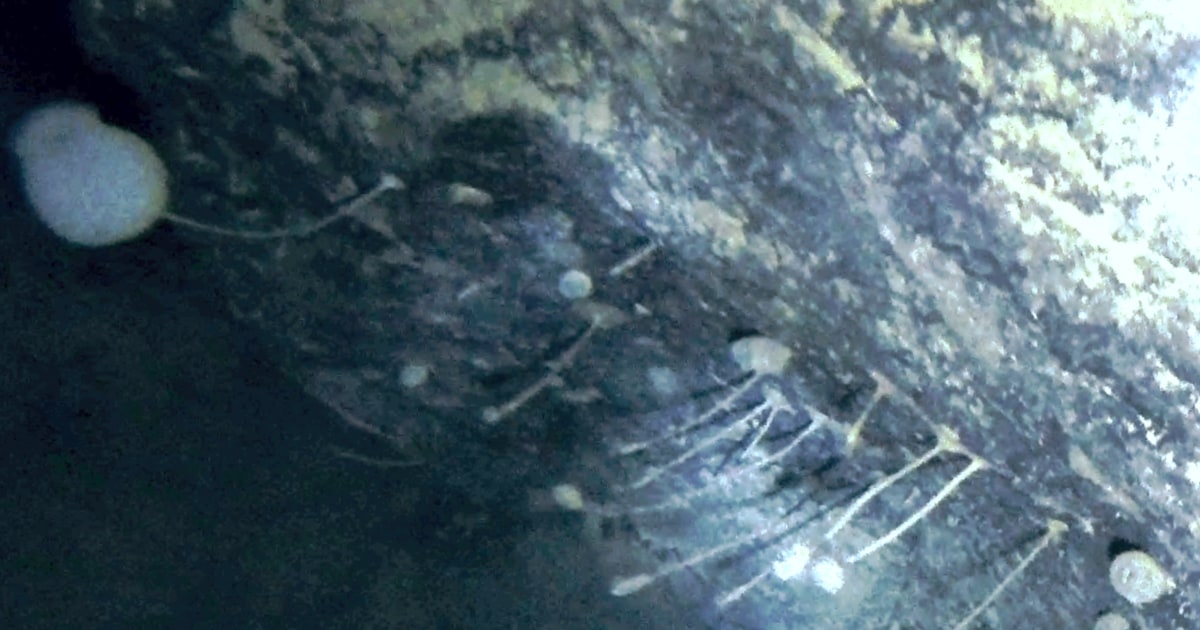“Life finds a way,” said actor Jeff Goldblum, who plays scientist Ian Malcolm, in the 1993 film “Jurassic Park”.
Animal life was not what scientists expected to find in pitch-black seawater under nearly a kilometer of floating ice in Antarctica, but it seems to have found a way with the discovery of sea creatures living in extreme environments.
Geologists removing sediment cores from the seabed under the giant Filchner-Ronne ice shelf at the southern tip of the Weddell Sea in Antarctica, have discovered what biologists believe are types of sponge. The discovery was published on Monday in Frontiers in Marine Science.
Geologists were more than 150 miles from the open ocean when they made a 3,000-foot-thick hole in the ice with a hot-water drill and lowered a ginning device and a video camera into the dark seawater below it.
They expected the seabed to be mud, but were dismayed when they hit a rock, which meant they did not get the desired sediment samples. But to his surprise, the camera showed colonies of “stationary” animals attached to the rock – probably sponges and other related sea creatures.
“It was a little disappointing for them – they spent weeks getting there and it didn’t work,” said marine biologist Huw Griffiths of the British Antarctic Survey, who is the lead author of the published study. “But for [biologists], it’s amazing because nobody has ever seen these [organisms] before.”
Antarctica is surrounded by more than half a million square miles of ice platforms – Filchner-Ronne is one of the largest, covering more than 160,000 square miles – but the holes have revealed an area of the seabed below them only the size of an tennis court. “It’s a huge area, but we have a small widow in it,” said Griffiths.
Small mobile animals, like shrimp and crustaceans called sea fleas, have already been seen under the ice shelves, but no one expected to see stationary animals like these. “The only things you would expect to find … are things that can wander around and find food,” he said. “Whereas if you are attached to a rock and are waiting for the food to reach you, then that piece that passed this year can pass through you.”
The bubble-shaped protrusions seen to the right of the video are clearly a type of sponge, while the creatures lurking on the left are similar to some other sponges found near Antarctica, he said. There are also indications that other animals may be attached to the stone, such as tubular worms, barnacles or hydroids, which are related to jellyfish.
To survive, organisms would have to feed on floating material from other animals or plants, because it is impossible for plants to photosynthesize in sea water without the sun. Although the rock is located about 150 miles from the ocean, the direction of the currents below the ice shelf suggests that the nearest plant life is up to 1,600 kilometers away, Griffiths said.
But the question of how these animals obtain food will have to wait until another scientific expedition can visit the site, perhaps equipped with a remotely operated underwater vehicle that can retrieve samples of the animals.
“All the ingredients for life exist under the ice shelves,” said John Priscu, a professor of polar ecology at Montana State University, who has studied life under polar ice for almost 40 years, but who did not participate in the latest study.
It seems that the animals trapped in the stone floated there like microscopic larvae and then grew into their adult forms: “life is everywhere and the environment selects the species that eventually thrive.”
A future step will be to determine whether the animals are similar to those in the open ocean or whether they have evolved to live where they are now, Priscu said by email. “[If] organisms have evolved to live under the ice shelves, they can provide us with a molecular clock that can be used to measure climate change in Antarctic ice.
The finding shows that life can exist in environments where science suggests it shouldn’t: “There are still things we have to learn,” said Griffiths. “There are still animals that can break the rules that we write for them.”

